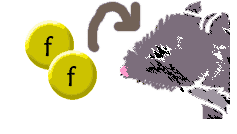Reviewing the Dreaded Double Hybrid

 Mr. and Mrs. Mouse both have one copy of each allele for teeth (one wild-type copy, one vampire fangs copy) -- they are hybrids for the vampire allele. They are also hydrids for a fur allele -
one copy of the fluffy fur allele, and one copy of the wiry fur allele. (Fluffy fur
is a recessive trait, like vampire fangs).
Mr. and Mrs. Mouse both have one copy of each allele for teeth (one wild-type copy, one vampire fangs copy) -- they are hybrids for the vampire allele. They are also hydrids for a fur allele -
one copy of the fluffy fur allele, and one copy of the wiry fur allele. (Fluffy fur
is a recessive trait, like vampire fangs).
 |
 |
Now there are two pairs of alleles in the mother's genotype. One allele pair has the vampire/non-vampire teeth. The other pair has flat/fluffy fur. But each egg gets only 1 allele from each of the pairs. So across the top of the Punnett Square, where we list all possible kinds of eggs, we have to list all possible combinations of one-allele-from-each-pair.
And the father has the same two allele pairs. To make a baby, Mr. Mouse flips his two coins, and Mrs. Mouse flips her two. We can make a Punnett Square to help us figure out what their babies should look like.
I know you've seen this kind of Punnett Square in Introductory Biology. But if you're like most people (including me), you don't quite remember where everything goes. However, please do not "look it up". I will ask you some leading questions, but the idea is for you to figure it out, then you won't need to memorize it or look it up.
1. Put Mom's egg choices along the top. Put Dad's sperm choices along the side. (Put the teeth gene first and the fur gene second). Each egg or sperm could have the allele for fangs or wild-type teeth, AND the allele for fluffy or wild-type fur. Click the buttons to see if you filled it out correctly. 2. That was the hard part. Now you get to click the button to fill out the kids genotypes! 3. By looking at each box, you can figure out what should each baby look like (i.e., what's its phenotype). So, fill in the questions below: |
If you followed these steps faithfully, you should end up with 9 wild-type babies, 3 with fluff, 3 with fangs, and 1 fluffy vampire (poor kid!)
This is the famous 9:3:3:1 ratio.
Copyright University of Maryland, 2007
You may link to this site for educational purposes.
Please do not copy without permission
requests/questions/feedback email: mathbench@umd.edu